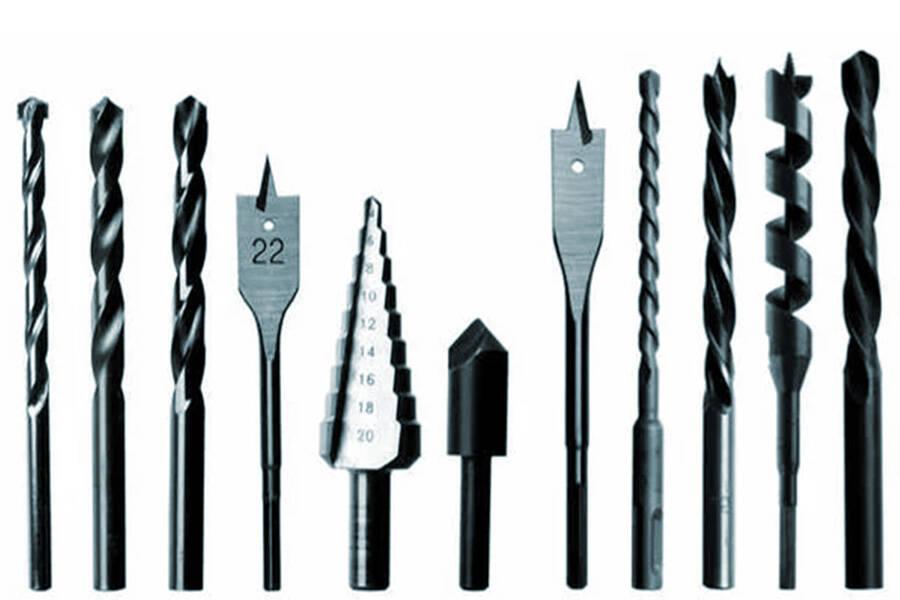Whether it is a DIY enthusiast building a beloved furniture, or a professional technician installing equipment and laying pipelines, drilling is one of the most basic and frequent operations. Faced with different materials (wood, metal, concrete, tiles) and different precision requirements, have you ever been confused by the dazzling array of drilling tools? Choosing the wrong tool is not only inefficient, but may also damage the workpiece and even bring danger. This article will sort out common drilling tools for you to help you choose accurately and easily conquer every drilling task!
What tools are needed for drilling?
Drilling may seem simple, but when faced with different materials (wood, metal, concrete, tiles) and operational requirements, choosing the wrong tool can result in low efficiency, crooked and rough holes, or even damage to the workpiece or even cause danger. LS will systematically sort out the core features and application scenarios of various mainstream drilling tools to help you make accurate choices and get twice the result with half the effort!
1. Hand drilling tools: precise control and small hole operation tool
(1)Hand Drill
①Working principle: manually rotate the handle, through the gear drive to drive the drill bit rotation.
②Core advantages:
- Ultimate control: clear feel, suitable for fine work (such as models, musical instruments).
- Silence and environmental protection: no noise and vibration interference.
- No Power Dependency: Best choice for wild or inconvenient environments.
- Typical applications:
③Drill holes < 10mm in cork, plastic.
- Precision carpentry positioning holes, drilling holes for jewelry inlay.
- Restoring antique furniture (avoiding damage from power tools).
- Limitations: Inefficient, physically demanding, not suitable for hard materials and large hole sizes.
(2)Trigger Drill (Ratchet Drill)
①Principle of operation: Using the ratchet mechanism, the drill bit rotates and cuts in one direction by repeatedly pressing down on the handle.
②Core Advantage:
- Simple and reliable structure: very low failure rate.
- Strong initial positioning force: not easy to slip when drilling on thick metal.
- Suitable for small spaces: no power cord constraints, small operating radius.
③Typical applications:
- Drilling of holes < 13 mm in metals such as steel plates, cast iron, etc. (especially initial positioning).
- Drilling in restricted spaces such as pipeline repairs, equipment compartments, etc.
- Safe operation in electrically sensitive areas (e.g. oil and gas sites).
- Limitations: Slow, labor intensive drilling and restricted hole sizes.
2. Electric drilling tools: the core engine of efficiency and power
(1)Electric hand drill (basic king)
①Working Principle: The electric motor drives the drill chuck to rotate at high speed.
②Core advantage:
- Lightweight and flexible: essential for home DIY, light weight and flexible operation.
- Versatile: Most of them have speed and torque adjustments, which can be used for both drilling and screwing.
- Strong compatibility: The standard three-jaw drill chuck is compatible with all kinds of straight shank drills.
③Typical Applications:
- Drilling of holes < 13mm in wood, plastic, plasterboard, thin sheet metal (< 3mm).
- Furniture assembly, installation of electrical appliances, hanging pictures on walls (non-load bearing walls).
- Daily maintenance, gardening trellis construction and other light work.
- Selection key: Power (500W-800W), battery voltage (12V-20V), clamping capacity (10mm/13mm).
(2) Impact drill (brick wall nemesis)
①Working Principle: Rotary + high frequency axial mechanical impact (generated by internal cam mechanism).
②Core Advantage:
- Penetration of brittle materials: Significantly improves drilling efficiency in red bricks, hollow bricks and lightweight concrete blocks.
- Dual use: “Pure drill” mode is compatible with electric drills, “Impact drill” mode specializes in brick walls.
③Typical applications:
- Installation of expansion screws and pipe clips on non-load-bearing brick walls and block walls (hole diameter 6-12mm).
- Punching holes in tiles (with a special drill and with the impact mode turned off).
- Lightweight concrete pre-embedded box opening.
- Important: ≠ Electric hammer! Cannot effectively drill through reinforced concrete. High noise and vibration during impact work.
(3)Electric Hammer (Concrete Terminator)
①Working principle: Powerful piston impact (cylinder mechanism) + auxiliary rotation (main chip removal).
②Core Advantage:
- Excellent penetration of hard materials: easy to deal with reinforced concrete, stone, thick brick walls.
- Efficiency: The first choice for professional construction, drilling several times faster than impact drills.
- Multi-functional expansion: Most support “drill”, “hammer drill”, “chisel” mode (with chisel trowel can be trenching).
③Typical applications:
- Drilling > 6mm deep holes in concrete beams, columns, floor slabs (installation of anchor bolts, through-wall sleeves).
- Wall trenching and demolition work (switching between chiseling and chiseling).
- Stone dry hanging, large equipment foundation fixing.
④Key features:
- Use of SDS-Plus or SDS-Max specialized shanks (efficient transmission of impact force, anti-loosening).
- Core parameters: Impact energy (Joule/J) (2J-20J+ determines rock-breaking capacity).
- Extremely noisy and vibratory, requires specialized protective equipment.
(4)Table drill (accuracy selection)
①Principle of operation: Clamped drilling machine, workpiece is brought forward to position drill.
②Basic advantage:
- High accuracy: guaranteed perpendicularity and depth uniformity.
- Energy-saving operation: Mechanical feeding, no handheld pressure needed.
- Stability: Avoid hole position drifting caused by hand shake.
③Typical applications:
- Metal parts machining (holes where high-accuracy positioning is required).
- Fine furniture manufacturing (mortise and tenon holes, location pin holes).
- Batch drilling operations (higher efficiency and consistency).
- PCB board drilling (small-sized bench drills).
④Weaknesses: Limited adaptability, workpiece size limited by table.
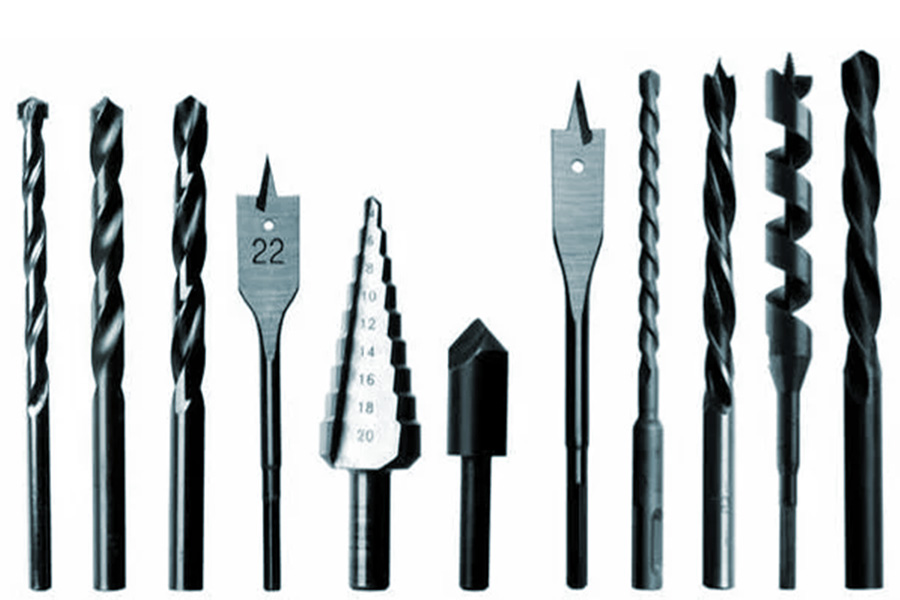
3. Rapid selection of tools: depending on the material and the need for exact matching
| Target material | Recommended drilling tools | Applicable hole diameter range | Typical application scenarios Examples |
|---|---|---|---|
| Cork, plastics | Hand drill, hand drill, bench drill | < 1mm - 30mm+ | Furniture assembly, modeling, plastic parts hole opening |
| Thin sheet metal (≤ 3mm) | Manual drills, bench drills | < 1mm - 13mm | Sheet metal processing, chassis drilling, metal brackets |
| Thick metal/cast iron | Trigger drills, hand drills (low speed), bench drills | < 1mm - 16mm | Equipment bases, steel connections, pipe flanges |
| Red/hollow bricks | Impact drills (impact mode) | 6mm - 14mm | Wall hangings, switch box installations, lightweight brackets |
| Lightweight concrete blocks | Impact drills (impact mode), lightweight hammers | 8mm - 16mm | External wall insulation fixings, small parapet foundations |
| Reinforced concrete/stone | Electric hammer (essential) | 6mm - 40mm+ | Load-bearing structure anchoring, through-beam casing, stone dry hanging |
| Tile/glass | Hand drill/impact drill (off impact) | 4mm - 12mm | Bathroom installation, kitchen fittings, glass shelves |
| Batch precision holes | Table drill | < 0.5mm - 16mm+ | Metal parts processing, PCB drilling, mold making |
How to drill wood holes?
Wood hole drilling is one of the most common operations in woodworking and DIY. As simple as it seems to be, mastering the right techniques will avoid defects such as burrs, cracks, and drill bit deviation, and also make drilling more accurate, efficient, and safe. Here is a step-by-step operation manual:
1. Core tool selection
(1) Drilling tools:
- Hand drill (most commonly used): versatile and efficient, suitable for most cases.
- Hand crank drill: suitable for precision work (e.g., models, small holes) or power inconvenience.
- Bench drill: High accuracy, batch drilling, or deep hole drilling preferred.
- Impact Drill (not suitable): No impact function is required in wood drilling, but it is easy to damage wood fibers when starting it up.
(2) Drill selection (key):
- Woodworking drill: Specialized for wood, high efficiency, smooth hole wall. Common types:
- Center Positioning Drill/Twist Drill: Sharp spikes center tip, accurate positioning and anti-slip, applicable to small and medium holes (<12mm).
- Flat Drill / Spade Drill: Front end center tip + two wide blades on both sides, quick drilling, good chip removal but hole wall rough, applicable to big holes (>10mm) or through holes.
- Hole opener: center guide drill + ring saw blade, specializing in opening big size holes (>30mm, such as door lock holes, threading holes).
- Countersink drills: Making conical countersink holes in through holes to hide screw heads.
- Common twist drill (optional): can be used for small holes in softwood, but low efficiency, easy to burr, hardwood or large holes not recommended.
2. Operation steps in detail
(1) Preparation
- Measuring and marking: The center of the hole can be marked accurately with a pencil and ruler, the crosshairs are easier to line up.
- Secure the workpiece: Clamp wood tightly to the workbench with a G-clamp, vise, or fixture. Hand-held operation is easily deflected and dangerous!
- Select drill bit: Select the appropriate woodworking drill bit for the hole diameter and accuracy, place it in the drill chuck, and secure.
- Put on protective gear: Goggles (to prevent wood chips from flying into the eyes), dust mask (to prevent inhaling fine dust), and avoid loose clothing/gloves (to prevent entanglement).
(2) Drilling Techniques
Identify the starting point:
- Align the drill point with the center of the crosshairs.
- Hand Drill/Hand Crank Drill: Place the drill bit firmly before drilling and use the center tip to make tiny indentations (locating pits) on the surface of the wood to prevent slipping.
Control the angle:
- Vertical drilling: Keep the drill bit exactly vertical to the wood surface (verify with the aid of a straight edge). Drilling at an angle will result in crooked holes, bent bits and even breakage.
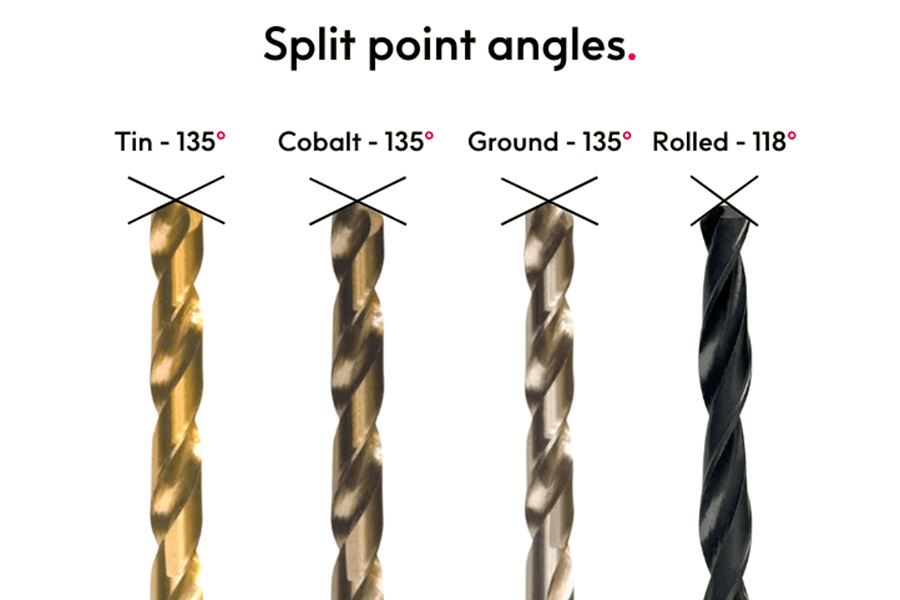
Control RPM:
- Softwoods (fir, pine): Medium to high speed (e.g. 1500-2000 rpm for hand drill).
- Hardwoods (teak, oak), laminates, plywood: low to medium speed (800-1200 rpm) to reduce the risk of scorching and burrs.
- Large holes (>10mm) or openers: Slower speeds to avoid too high a torque causing loss of control.
Feed strength:
- Apply light pressure at first, then feed smoothly and evenly once the bit is fully bitten into the wood.
- Avoid over-pressure: Excessive pressure will result in overheating of the bit, hole wall chipping or chipping of the wood at the rear.
In deep hole drilling, remove the drill bit every 10-15mm to remove wood chips in the drill slot to prevent clogging and overheating.
(3) Special Scenario Handling
Drilling through holes:
When the drill bit is about to come in, reduce the pressure significantly or discontinue, turn the wood over and reverse the drilling confluence from the rear, which can avert the wood bursting at the exit.
Or pad a scrap wood board piece under the work for the safety of the drill bit and table while drilling through.
Drilling deep holes:
Use a long drill bit and strictly follow the "exit chip removal" principle.
Marking the drill depth: Use tape on the drill to mark the intended depth.
Drill large holes (>30mm):
Either use a hole opener: low-speed drill into the center guide to position the hole, then advance the circular saw blade evenly forward.
Or sequential drilling: initially drill using a small bit, then gradually use a larger bit to enlarge the hole.
Hardwood/Laminate:
Pre-drill pilot holes with a small drill bit (e.g. 3mm) and then change to a target drill bit for reaming, with less deflection and less burring.
Thin wood panels:
Scrap board must be padded underneath to prevent tearing when drilling through.
3. Common problems and solutions
| Problem | Possible cause | Solution |
|---|---|---|
| Hole edge roughness | Dull drill bit, too high RPM, too fast feed | Replace with sharp drill bit; reduce RPM; feed at a constant speed. |
| Hole position shifted | Workpiece not secured; no pre-pressure of the locating pit | Clamp the wood; press out the locating pit with the center tip. |
| Hole wall burnt | Drill bit blunt, speed too low, chip removal not smooth | Replace new drill bit; increase speed; frequently back out and clean chips |
| Backside wood cracked | Pressure too high when drilling through hole | Reduce end pressure; drill on the reverse side or back up with backing board |
| Drill bit stuck/smoking | Chip chute clogged; deep hole drilling without chip removal | Stop drilling immediately! Fully back out and clean up wood chips |
With these hints in mind, you'll be able to drill spotless, clean holes, whether furniture making, laminate or DIY woodwork installation!
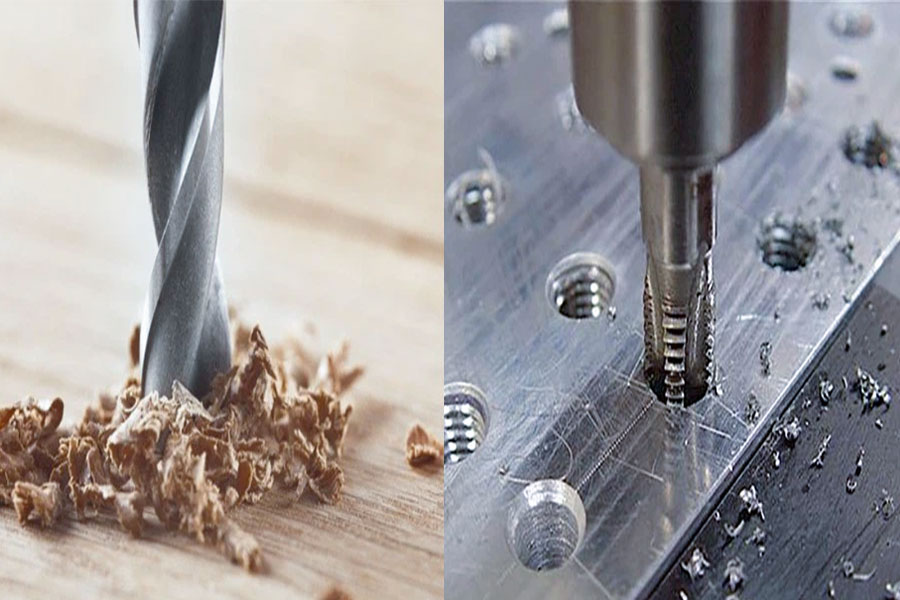
How to drill holes in metal?
Metal hole drilling is a useful skill in metalwork, machine repair, and home renovations. Metal is hard and a good conductor of heat relative to wood, and thus careless handling can easily result in burned drill bits, crooked holes, and even splash cuts to workpieces. With the right skills acquired below, you will safely and efficiently drill accurate metal holes!
1. Preparing core tools and consumables
(1) Selection of a drilling tool:
- Bench drill (optimal): provide the greatest stability and vertical accuracy, especially for heavy metal or accurate machining.
- Electric drill (standard): versatile and convenient, need to be used in conjunction with a drill stand or guide to improve accuracy (easy to transport using bare hands).
- Magnetic drill (professional): for steel frames of large diameters, adsorption of workpiece + automatic feeding, fast drilling of large holes.
⚠️ Impact drills are prohibited: the impact function at once destroys the cutting edge of the metal drill!
(2) Drill selection (the success or failure factor!)
Material:
- High Speed Steel (HSS): Inexpensive and average, for mild steel, aluminum, copper and other soft metals (thickness <5mm).
- Cobalt high-speed steel (HSS-Co, e.g., M35): 5%-8% cobalt, heat resistance ↑↑, capable of drilling stainless steel, alloy steel, cast iron.
- Drill carbide: very hard and abrasion-resistant, best in hardened steel of high hardness, wear-resistance cast iron, but highly brittle and prone to chipping.
Geometric angle:
- 118° drill tip angle: general-purpose angle, a compromise between penetration force and life.
- 135° drill tip angle: sharper, reduced axial force, good for stainless steel, hard steel, anti-hardening.
- Flute design: High-performance drills with polished spiral flutes or chipbreaker flutes to maximize efficiency in chip removal.
(3) Auxiliary consumables
- Cutting fluid/lubricant: Absolutely necessary! Cooling + lubrication + extend the drill life (suggested: sulfurized cutting oil, special metal drilling paste).
- Center punch/specimen punch: Precise placement in order not to have drill bit slipping.
- G-clamp/vise: rock-solid holding of the workpiece!
- Goggles + cut-resistant gloves: prevent people from getting injured by metal chips.
2. Standardized operation process
(1) Safety preparation stage
- Clamping the workpiece: use a vise or a fixture to clamp the metal firmly on the worktable to avoid shaking.
- Protection: Goggles (anti-flying chips), cut-proof gloves (anti-burr cutting), no common gloves (anti-contact).
- Clean up the surface: Remove oil, rust, and make the point of drilling even (use a file to level the surface if not even).
(2) Precise setting and starting drill
- Center marking of the hole: Scribe needle + steel ruler to accurately mark center of the hole at the intersection of crosshairs.
- Play positioning pit: use the center punch to align at the center of the cross, hammer to drive the depth of > 0.5mm pit (absolute anti-slip key!). Punching the pit
- Clamping drill bit: Select appropriate drill bit size, ensure that the drill shank does not vibrate in the drill chuck, and clamp it with full torque.
(3) Drilling parameter control
| Parameters | Operating Points |
|---|---|
| Speed | Hard metal (steel, stainless steel): low speed (300-800 RPM) Soft metal (aluminum, copper): medium speed (1000-2500 RPM) The larger the hole diameter, the lower the speed (e.g.: 500RPM for a 10mm hole) |
| Feed force | Maintain a steady and continuous pressure to avoid sudden changes in weight. Drill thick metals in stages: small hole → medium hole → target hole (e.g.: 3mm → 6mm → 10mm) |
| Cooling and lubrication | Apply cutting fluid continuously throughout the process! Add fluid every 2-3mm of drilling and exit, and the drill temperature must not exceed 150℃ (limited to being able to touch by hand). |
(4). Key Operation Tips
- Vertical drilling: align the tip of the drill bit with the locating pit, start the motor and test drill with light pressure, make sure there is no slippage and then increase the force at a constant speed.
- Discharge management: Every time the drill bit is drilled into a depth of 2-3 times the diameter of the drill bit, completely withdraw from the drill to remove iron chips from the spiral groove (to prevent clogging and burning of the drill).
- Penetration phase: Reduce the force by 50% when the drill is about to penetrate, to avoid metal edge tearing or drill bit jamming and chipping.
- Deep hole treatment: Drill in sections + retreat chips diligently, use extended drill bit or gun drill (depth to diameter ratio >5).
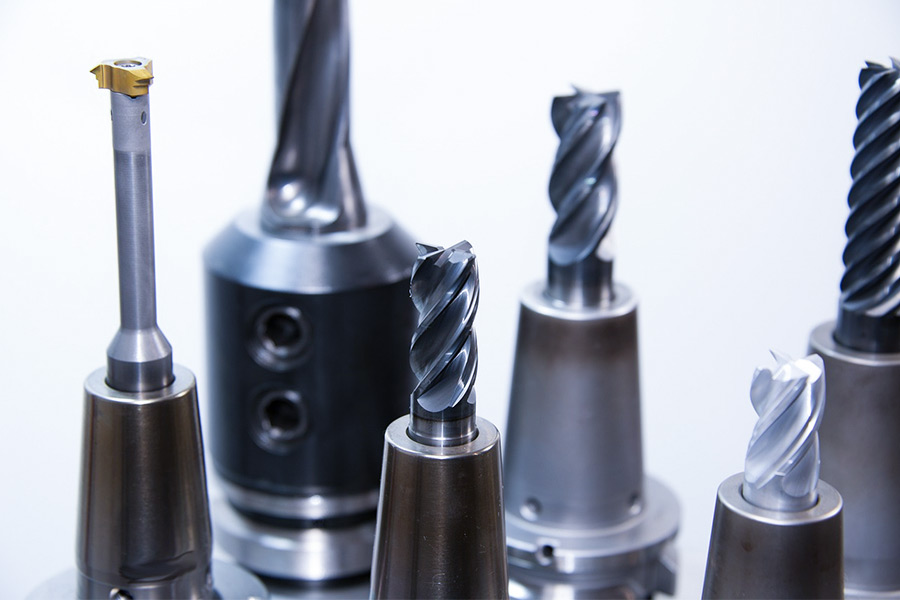
3. Drilling strategies for different metals
| Metal type | Drill selection | Speed recommendation | Special treatment |
|---|---|---|---|
| Low carbon steel | HSS 118° drill tip | Medium-low speed | Conventional cutting fluid is sufficient |
| Stainless steel | HSS-Co 135° drill tip | Low speed | High lubricity cutting oil, anti-hardening |
| Aluminum/aluminum alloy | HSS special aluminum drill bit | Medium-high speed | Alcohol or kerosene cooling, anti-built-up edge sticking |
| Brass/red copper | HSS 118° drill tip | Medium speed | Reduce feed force, prevent the drill bit from automatically cutting in |
| Cast iron | HSS-Co or carbide | Low speed | Dry drilling! Cutting fluid accelerates wear |
| Titanium alloy | Carbide drill bit | Ultra-low speed | High-pressure cutting fluid, extremely low feed speed |
4. Troubleshooting of high-frequency problems
| Problem phenomenon | Root cause | Solution |
|---|---|---|
| The drill bit instantly burns red. | The speed is too high + insufficient cooling. | Reduce the speed! Continue pouring cutting fluid. |
| The hole position is seriously offset. | The positioning pit is not made/the workpiece is not fixed. | Punch the pit at the center + re-clamp the workpiece. |
| The drill bit is broken. | The feed force is too large/the material has hard spots. | Drill in stages; replace the cobalt-containing drill bit. |
| The hole wall is rough and burred. | The drill bit is blunt/the speed is too low. | Replace the new drill bit immediately; increase the speed. |
| The drill bit is stuck to the metal. | Aluminum built-up edge/feed is too slow. | Increase the speed + kerosene cooling; increase the feed. |
| Stainless steel becomes harder as it is drilled. | Work hardening (heat accumulation). | 135° drill tip + heavy cutting oil + constant feed. |
How to drill holes in plastic?
Drilling holes in plastic requires special attention to material properties and drilling techniques to avoid cracking, melting or burrs. The following is a step-by-step guide and professional advice:
1. Tool and Drill Selection
Drilling Tools
Hand drill (preferred): needs to have a speed control function (recommended speed range 500-1500 RPM).
Bench drill: suitable for high-precision needs (e.g., acrylic signage).
⚠️ Impact drills are prohibited: impact mode can cause plastic cracking.
Drill Type
| Plastic type | Recommended drill bit | Key features |
|---|---|---|
| Hard plastic (ABS, acrylic) | Triple-point woodworking drill bit | Center tip for precise positioning, anti-slip |
| Soft plastic (PE, PP) | Spade drill/step drill | Wide blade reduces material pulling |
| General plastic (PVC, PC) | Ordinary twist drill (HSS) | Need to blunt the drill tip (see modification below) |
Drill modification tips:
Use a grinding wheel to grind the drill tip angle of the twist drill to 90° (as shown below) to prevent the drill bit from "biting" too deep.
Or use a file to slightly blunt the edge to reduce cutting sharpness.
2. Operation steps and tips
(1)Safety preparation
- Fix the workpiece: Place a waste wood board or foam board under the plastic and clamp the edge with a G-type clamp (>3cm from the drilling point).
- Protective gear: Wear goggles (to prevent flying chips) and a dust mask (especially fiberglass plastic).
(2) Drilling process
- Marking positioning:
Use a center punch or needle tip to gently press out the positioning pit (required for hard plastics such as acrylic).
Thin plastics (<3mm) can be covered with masking tape to prevent slipping.
- Speed setting:
| Plastic Type | Recommended Speed | Feed Pressure |
|---|---|---|
| Acrylic/PC | 300-500 RPM | Very Light Pressing |
| ABS/PVC | 800-1200 RPM | Even Light Pressing |
| PE/PP | 200-400 RPM | Intermittent Pressing + Cooling |
- Cooling and chip removal:
After drilling 3-5mm, withdraw the drill bit and cool it for 2 seconds (the drill bit should not be hot to the touch).
Acrylic can be cooled with spray water (oil-based cutting fluid is prohibited).
(3)Penetration treatment:
When the remaining 1mm is drilled to the bottom, reduce the speed by 50% or turn the workpiece over and drill through from the back.
3. Burr treatment
Use a deburring knife or 600-grit sandpaper rolled into a stick to polish the hole edge.
Acrylic hole: Use the flame of an alcohol lamp to quickly sweep over the edge for polishing (practice is required).

Choose LS for your drilling projects
LS is an ISO certified company specializing in holemaking and CNC machining services for a wide range of machined parts, regardless of the complexity of the internal features and tolerance requirements. We focus on our customers’ economic drivers, ensuring reduced costs and shorter lead times. Want to learn more about our holemaking services or request a quote? Contact us today.
Summary
Drilling may seem simple, but choosing the right tools and drill bits is the key to completing the work efficiently, safely, and with high quality. Understanding the fineness of a hand drill, the flexibility of a hand drill, the breakthrough of an impact drill on a brick wall, the power of an electric hammer on concrete, and the pertinence of various drill bits will allow you to handle various drilling challenges with ease. Before you start next time, take some time to evaluate your materials and needs, choose the right "drilling tool", and make every drilling a relaxing and enjoyable experience! For large or complex projects, consulting professionals is always the safest choice.
📞 Phone: +86 185 6675 9667
📧 Email: info@longshengmfg.com
🌐 Website: https://lsrpf.com/
Disclaimer
The content of this page is for informational purposes only.LS SeriesNo representations or warranties of any kind, express or implied, are made as to the accuracy,completeness or validity of the information. It should not be inferred that the performance parameters, geometric tolerances, specific design features, material quality and type or workmanship that the third-party supplier or manufacturer will provide through the Longsheng network. This is the responsibility of the buyerAsk for a quote for partsto determine the specific requirements for these parts.please Contact us Learn more information.
LS Team
LS is an industry-leading companyFocus on custom manufacturing solutions. With over 20 years of experience serving more than 5,000 customers, we focus on high precisionCNC machining,Sheet metal fabrication,3D printing,Injection molding,metal stamping,and other one-stop manufacturing services.
Our factory is equipped with more than 100 state-of-the-art 5-axis machining centers and is ISO 9001:2015 certified. We provide fast,efficient and high-quality manufacturing solutions to customers in more than 150 countries around the world. Whether it's low-volume production or mass customization,we can meet your needs with the fastest delivery within 24 hours. chooseLS TechnologyIt means choosing efficiency, quality and professionalism.
To learn more, please visit our website:www.lsrpf.com

FAQs
1. What is the most commonly used tool for drilling?
The most commonly used and efficient tool is the electric drill, which uses electricity to drive the drill bit to rotate at high speed to drill holes in various materials. It is indispensable for home DIY and general engineering work; if you need to deal with particularly hard concrete or brick walls, you usually use an impact drill or a more professional electric hammer, which can generate impact force while rotating and easily break hard materials.
2. Do I need different drill bits for drilling different materials?
Yes, drill bit selection is crucial. High-speed steel (HSS) drill bits are suitable for wood, plastic and softer metals; for hard concrete, masonry or tile, carbide drill bits or masonry drill bits with carbide tips (usually tungsten steel) at the front must be used; when processing metals, especially harder steels, cobalt-containing drill bits are the first choice due to their excellent heat and wear resistance; when drilling wood, woodworking drill bits (such as twist drills or flat drills) can bring cleaner holes.
3. What are the important safety precautions when drilling?
Safe operation is the first prerequisite: be sure to wear goggles to prevent flying debris from hurting your eyes; ensure that the workpiece is firmly clamped in a vise or workbench to avoid accidental movement and danger; keep your body stable and balanced during operation, hold the electric drill tightly, and confirm that the drill bit is firmly installed and aligned with the marked position before starting; especially when the drill bit is about to penetrate the material, it is necessary to appropriately reduce the pressure and control the speed to prevent sudden penetration from causing the drill bit to jam or the workpiece to break and splash.
4. What should I do if the drill bit is stuck or "bitten" by the material and cannot turn?
Do not force the drill to turn or pull it at this time. First, release the trigger immediately and turn off the power to avoid burning the motor or spraining your wrist. Then try to switch the drill to reverse mode (Reverse), operate it carefully and slowly, and use the force of reverse rotation to get the drill bit out of the stuck state. If the drill bit is stuck deeply, if possible, carefully shake the drill bit back and forth or gently tap its side to help loosen it. The key to preventing the drill from getting stuck is to keep the drill bit sharp, pull back and clean up the debris in time during drilling, and apply steady and appropriate pressure to avoid letting the drill bit sink too deep.


